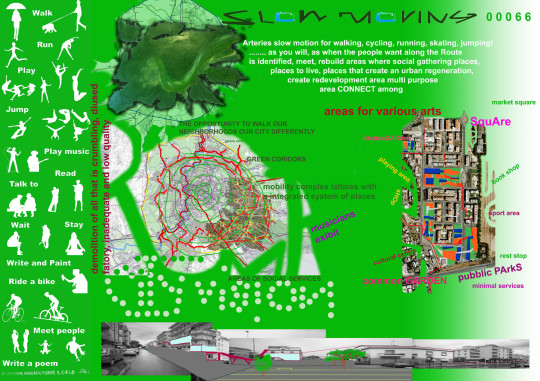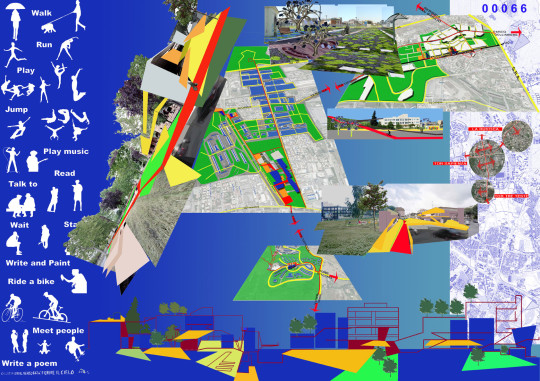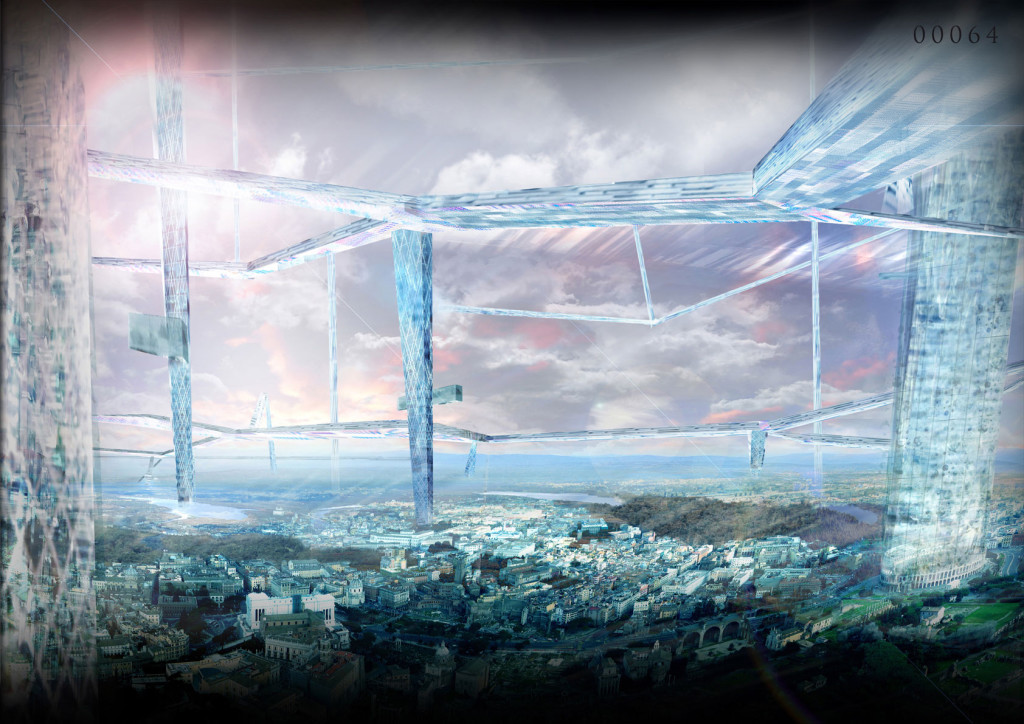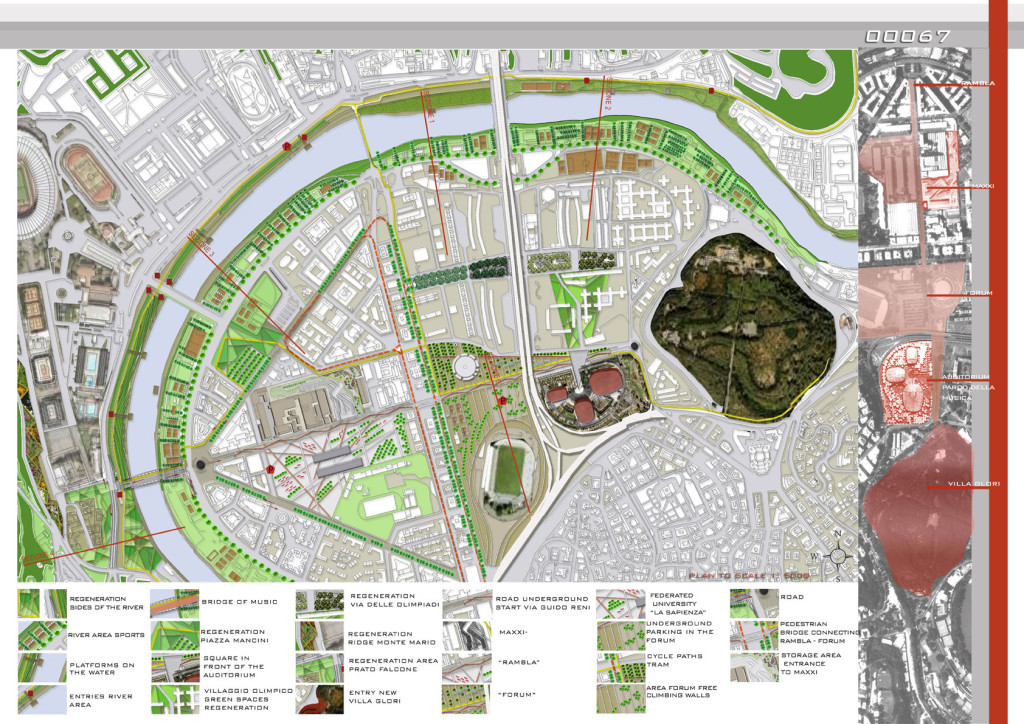Info:
Title: Slow Movings - Code: 00066Contest: Rome / 2010
By: A. Cicchinelli / M. Alexis / V. Caradonna / V. D’Ambrosio / F. Fantinel / A. Mazzei / E. Calbucci
Views: 2200 Likes: 0
Votes:
JUERGEN MAYER H. 0 FRANCESCO LIPARI2 FELIPE ESCUDERO1 FRANCESCO GATTI 4 MICHAEL CATON 72.8
Slow Movings


An ideal path that winds through town.
We follow it on foot, by bicycle, slowly. This is not how we usually travel on a daily basis to make our way around Rome. Although the route is the same, the views that you will see and the scenery that you will encounter will be different when travelling by foot or by bicycle.To our group a new vision of Rome must start from time-scanning.
In a city of undeniable beauty, we realize that people do not see this beauty or maybe they just do not have the time to step back and appreciate it. In suburbs that lack this beauty, you can not create new ones.
To us beauty is enjoying places all around throug inputs and opportunities that the each site has to offer.
Focusing the project on the creation and use of space for living more than crossing, we
propose the introduction of a “slow motion” field that invests throughout our city, a network of mobility alternative to our everyday experience of crossing the chaotic city that still allows us to get there.
Whereas roman strong movement is radial, developing in different time slots between the consulars and the center, the new movement is transversal, a spiral connecting the center to the big flow arteries.
By Reconnecting the parts of the city, including the streets, that are often completely isolated from each other, we touch on the realities mentioned above and therefore making them accessible. This can be done by developing places along this path where people can stop and rest or enjoy the surrounding scenery, where people can come together and talk and enjoy the views..
In many cases quality features already exist but their disconnection makes them divorced from everyday life, inaccessible oasis.
If we take our city towards a different direction, by changing the spatial and temporal perspective through which we see,will enable us to experience everything differently. Whether we walk, travel by bicycle, skatejourney by boat or use a wheelchair we can finally do this in our own time and not be dictated by the metro.
We propose a use of the city which will incorporate different heights and perspectives, thus recovering not only the spaces available to us at ground level but also at different heights. Incorporating large terraces floors of many buildings, and also bringing to life the reality of subterranean Rome, use of ditches and channels leading to the river.
Our design idea, from a global concept and the application, comes through illustrative excerpts in small scale.
A large scale
The spiral path is ambiguous, pedestrian and cycle paths, and links across different parts of our city. Along its path we will find our neighbourhoods, the river, bicycle paths and parks already in place, existing services and not excluded, the public transport lines, surface and underground.
Many suburbs are so poor in resources and opportunities for participation and social mobility, obstacle courses full of environmental and social, with some infrastructure like overpass, railways and roads to travel faster than stand as a barrier or fracture intrusive which helps to limit accessibility, crossing the enjoyment of much of our city.
The slow movement is an advocate of urban regeneration, an integrated system of places that are reclaiming their identity and at the same time creating new stimuli. Places open and semi-skilled where we can express our need for sociability, separate from the dwelling, but also from public spaces real.
At intermediate scale
For each district, along the way, you can locate multipurpose areas linked together, and talk about squares, public parks, playgrounds, to make music for the various arts, sports, places to eat (pub shops, etc..) and services (markets, cinemas, cultural centers, etc..), each district organized according to his vocation.
We also introduce ecological islands where people can bring together their simplifying waste disposal.
Introduce areas for the production of alternative energy when you can meet their own needs major energy (water heating, lighting), with the use of photovoltaic and composting
All of these individuals in the urban areas and strategic use those currently available is occupied by freeing some ugliness, demolishing all the buildings dilapidated and disused, the poor quality of the city so great, that in fact characterize architectural horrors with their presence the liveability of many suburbs.
Trying to identify the presence of active services both public and private arrangements to be made with the new services. All linked by pedestrian paths, creating underpasses for road traffic is formed in fact a network of protected routes and in some cases we have seen can give access to areas that are currently difficult to access.
We selected four sites as examples, 4 tracks of our urban periphery:
-Tuscolana:
An area on the edge of the built along the consular characterized by the presence of many urban spaces, green areas abandoned, disused industrial buildings
- Tor Tre Teste:
We have identified an area near the church dedicated to God the Merciful Father, characterized by a building-ruin and a parking not finished, a green area already partially used for children’s play area, schools, a supermarket
- Tor Sapienza:
It was detected a band that combines both areas built more recently with the historic settlement. It is an area that already has not studied in a range of services such as schools, local market, sports, public services, besides the presence of brownfield sites and abandoned buildings. the green parts are also unrelated to each other and in some cases with difficult access, through the presence of fast roads. The lack of a link between the parties is likely to be unable to create unity, that “center” which the district requires
- La Rustica:
We have chose the area of the railway station. The section was buried here and in fact has been a long area that is currently available left completely abandoned. Nearby there is structured to green areas or children’s play areas or sports, but also desolate areas or landfills.
It’s central position in the district with the introduction of new services can become the center from which wind power as alternative routes to.
At small-scale
The next step is the upgrading of neighbourhood liveability of isolates, where many paths to unravel that thread-the main route and take in our daily lives.
We go this way in the backyard, climb the rooftops, and jump from floor plan, we create gardens, rooftop plazas, play areas for children reached home with locations in several heights.






